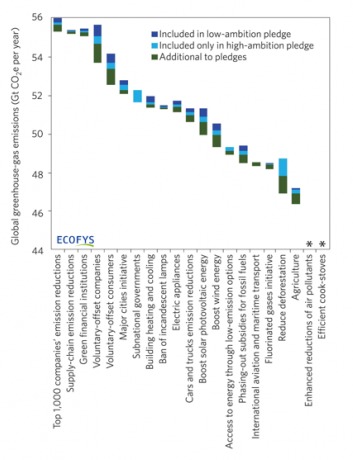
Photo by Rachael Voorhees.
This week, representatives of nearly every country in the world are in Rio de Janeiro attending a meeting hosted by the United Nations that happens once every 10 years. While there, the world could come together and agree to a plan that will effectively reverse decades of carbon pollution.
It won’t. There are a lot of reasons why no grand accord will result from Rio: politics, economics — every nation, it seems, has its own reasons. But perhaps the problem isn’t the convocation. Perhaps the problem is the expectation that there’s a climate change silver bullet.
A new paper from researchers in Germany and the Netherlands suggests that an incremental approach to closing the gap between where emissions are and where they need to be may be easier and more successful. Without any change in greenhouse gas emissions, the world will be creating 12 more gigatons of carbon dioxide a year than we should be in order to prevent worst-case global warming. In order to close that gap, the research team sought to identify areas that share four characteristics:
- There’s existing traction.
- There are benefits besides greenhouse gas reduction.
- There are organizations or individuals that can lead on the issue.
- Action can achieve a reduction of one-half billion tons of carbon dioxide by 2020.
As detailed at Nature Climate Change, they identified 21 initiatives that meet the four above characteristics. The combined impact of bringing those initiatives to scale, as outlined in the graph below, brings CO2 output to near the target range of 44 gigatons a year, reducing output almost the full 12 gigatons it would take to do so.
(Each of the subject areas, including the two asterisked, are discussed here.)
The authors describe why they’re optimistic:
Why will this work? Action by an individual citizen, a municipality or even a large multinational company may be considered ‘a drop in the ocean’. Even individual actions by large companies or big cities will rarely have an impact of more than a few megatonnes of carbon dioxide equivalent. However, being part of a larger coalition that has the potential to completely bridge the entire emissions gap will make it much more attractive to participate in and take action. To this end, it is necessary that globally leading organizations in the world of business, governments and non-governmental organizations (NGOs) participate. They need to be part of a coalition that together provides leadership in bridging the gap. Therefore, the key to the success of the wedging-the-gap approach is forming and sustaining this coalition.
Were participants in Rio to adopt this strategy, “wedging the gap,” there’s no guarantee of success. But for a movement long criticized for an impractical carpet-bombing approach to addressing climate change, a series of surgical strikes orchestrated by a diverse group of leaders toward practical tactical outcomes could be more successful, could be easier to generate support — and could possibly make a real dent in global greenhouse gas emissions.




